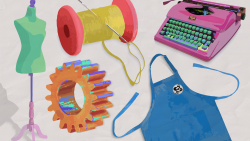Wisconsin is one of those states that I just never thought I’d visit. Like Iowa, Missouri and most other Midwestern states, it wasn’t high on my list of places to see. Last July, however, I found myself driving across the Minnesota-Wisconsin border with my Minneapolis-born boyfriend. I didn’t know what to expect other than a lot of lakes and farmland.
I was surprised to find that Wisconsin can be rather entertaining, as long as you have a sense of humor about cranberry bogs, Republicans and taxidermy. My favorite roadside distraction though was the Wisconsin Cement Park. Despite its industrial-sounding name, the park does not churn out tons of limestone powder. It’s actually a roadside art gallery tucked behind a short, colorful fence and a few evergreens.
I was skeptical at first. The grassy grounds of the park were well-kempt, the gravel parking area more than adequate. A sad, half-mile walking trail beckoned from the woods. A wooden latrine sat a few hundred yards behind the statues. Angular cement statues of horses and men, an angel, a giant fish and many other figures laced the park. The creations of the late Fred Smith, these light gray monuments of Americana, were each built around a wire frame and decorated with colorful glass (green or clear broken bottles, mainly, and the occasional salt shaker). The dozens of statues stood about six or seven feet tall.
The sign next to a cement Paul Bunyan noted that the sculptor could neither read nor write. For a man without a formal education, Smith deserved credit for originality. Presumably, he knew nothing of S-curves, the Venus di Milo or any pretentious art history method, yet he was able to make his own-albeit rather strange-mark on the midwestern art world.
As interested as I was, I admit that I didn’t read nearly enough signs to get an accurate sense of Smith’s life. I preferred to have him linger in my mind as his own sort of tall tale: A man in 1950’s middle America, devoting his creative life to cement and broken bottles. He had a painfully ordinary name-Fred Smith-yet he was able to create these unique statues. I wondered why he chose this field as his career. Perhaps cement offered him a respite from farming, logging or traveling across the continental United States Bunyan-style with his own giant, blue ox.
Before leaving, we looked through the gift shop. We wandered among the Christmas ornaments (it was July, mind you), hand-knit baby sweaters and other homely, paraphernalia completedly unrelated to cement. I selected a postcard and examined the yellow, tattered local newspaper clippings praising Mr. Smith’s works that were strewn across a white table. A woman came in and requested “one of those cat hotels you make.” I couldn’t imagine what a cat hotel could possibly be, nor could I fathom why this woman would want one. We headed for the car.
Back on the road, I reflected on my Wisconsin experience. The overabundance of taxidermy shops may have baffled and unsettled me, but the Wisconsin Cement Park supported my theory that roadside attractions can be some of the most entertaining stops in life. You never know when the road will lead you to the artwork of a plainly-named, illiterate sculptor. You had better be ready to face his legion of cement horses with a smile.



